May 11, 2015
by Carole Zangari -
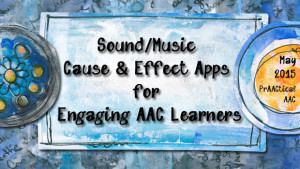
AAC clinicians are a creative bunch. Recently, I had the opportunity to visit some colleagues and was excited to see how they are repurposing free/low cost apps to build engagement and interaction in learners with significant communication challenges. Many of us work with learners who are highly motivated by mobile devices and apps that make music or sound, but still have a way to go to build their skills in using them. For some, we find that using apps that are relatively simple and easy (both motorically and cognitively), can spice up a session. Here are some sound/music cause and effect apps to explore. Of course, these apps are intended for a purpose completely different than how we are using them in therapy. Nonetheless, kids love them and that means that we SLPs can get a lot of mileage out of using apps like these in our therapy sessions. Burp... [Read More...]
Filed under: PrAACtical Thinking
Tagged With: Apps, cause and effect, implementation ideas, music
May 10, 2015
by Carole Zangari -
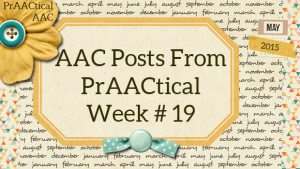
Monday – Core Vocabulary Resources for May Tuesday – How I Do It: Classroom Support for Students with AAC Needs by Tina Moreno Wednesday – Video of the Week: Multimodal Communication in the Classroom Thursday – PrAACtically Reading: The Cat in the Hat with Karen Natoci
Filed under: PrAACtical Thinking
May 7, 2015
by Carole Zangari -
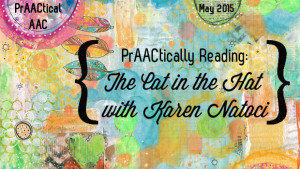
Who doesn’t love reading books by Theodor Seuss Guisel? Michigan-based SLP Karen Natoci is back to show us how she is using one of his most beloved books to integrate language and literacy instruction with the AAC learners in some of the classrooms she serves. Be sure to download her lesson plan and watch the video clip of Karen in AACtion. Enjoy! :::::::::::::::::::::::::::::::::::::::::::::::::::::::::::::::::::::::::::::: CLASSIC Book: The CAT in the HAT, by Dr. Seuss Core Vocabulary focus: LOOK, NOT, LIKE, NOT LIKE, NO, GO, DO, UH-OH or OOPS. COMMUNICATION Matrix Level: I-VII Four Block focus: Shared Reading and Working with Words (at the alphabet/rhyme level) ————————————————————————————————————————————- It is Spirit Week at our school and Monday is Hat DAY!! What better excuse to read, The Cat in the Hat!! The rhythm of the reading along with the site of all of our wacky hats made for a fun morning in room 8!... [Read More...]
Filed under: PrAACtical Thinking
Tagged With: Books, Karen Natoci, literacy, PrAACtically Reading, reading
May 5, 2015
by Carole Zangari -
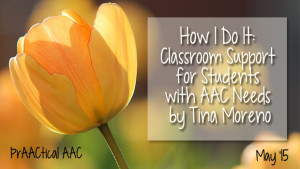
We are fortunate to have a return visit from Tina Moreno, who brings her experiences both as an SLP and also as a mom of a teenager who has used AAC for most of his life. In this post, Tina shares some of the strategies that she has used to support AAC students in their classrooms. If you are a school-based SLP, don’t miss Tina’s classroom observation form for gathering data on how AAC is being used in various activities and lessons. GIVE THEM FIVE As an SLP in the school setting, helping teachers support students in the classroom can be a big challenge. While we can see students making progress in our therapy sessions, it can be difficult to get the same results in the classroom. An important role of the SLP is to collaborate with teachers to help students generalize these skills in conversation with their peers and other... [Read More...]
Filed under: PrAACtical Thinking
Tagged With: assessment, classroom, forms, implementation ideas, intervention, resources, Tina Moreno
May 4, 2015
by Carole Zangari -
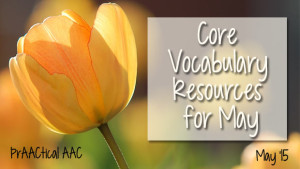
It is hard to believe that April is behind us and that we are now focusing on new set of core words for May. Whether you are following along with the 2013 Year of Core (12 words/month) or the 2014 A(nother) Year of Core (16 words/month; Different than the previous year’s core words), or just getting started, here are some helpful resources. Our words for this month are as follows. 2013 List: all, down, good, little, my, question, sad, she, turn, up, who, why 2014 List: bathroom, car, child, confused, green, hard, how much, man, mean, never, part, remember, sister, so, today, us A great many thanks to our colleagues Russell Cross, Gail Van Tatenhove, Allison Wade, Heidi LoStracco, and all the others who have contributed to this effort. Templates for you to plug in your own symbols: 2013 words, 2014 words Minspeak/Unity version: 2013 words PCS versions: 2013 words, 2014... [Read More...]
Filed under: PrAACtical Thinking
Tagged With: Year of Core
May 3, 2015
by Carole Zangari -
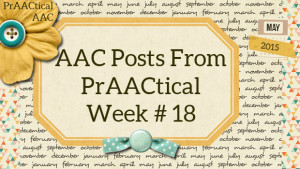
Monday – 5 Ways to Use Word Clouds in AAC Therapy Tuesday – PrAACtically May: Core Word Calendar by Rachael Langley Wednesday – Video of the Week: SGDs for People with ASD Thursday – How We Do It: Using Language Boards to Support AAC Use By Nerissa Hall and Hillary Jellison
Filed under: PrAACtical Thinking
April 30, 2015
by Carole Zangari -
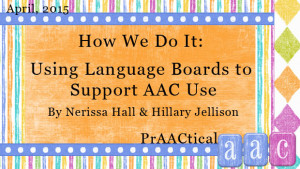
Many of you have reached out to say how much you’ve appreciated the prAACtical suggestions provided by Nerissa Hall and Hillary Jellison, New England-based SLPs and owners of Commūnicāre, LLC. We’re excited to have them back, especially because they are talking about something near and dear to our hearts: Implement a core vocabulary approach in their AAC therapy. In this post, they give us a peek into the ‘why’ and ‘how’ of making and using communication boards that are rich in core words. In their typically generous fashion, they also share templates for the boards that they make. How We Do It: Using Language Boards to Support AAC Use There are a number of different strategies one can use to support an individual’s use of augmentative and alternative communication (AAC). We know that aided language stimulation, augmented input, and AAC modeling are important and effective ways of supporting AAC use. By using... [Read More...]
Filed under: PrAACtical Thinking
Tagged With: Communicare, Hillary Jellison, language boards, Nerissa Hall, resources
April 28, 2015
by Carole Zangari -
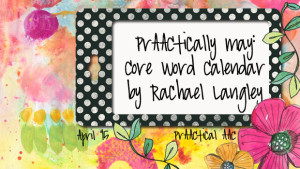
Michigan-based SLP Rachael Langely is at it again! She developed a wonderful calendar of activities for those following along with our Year of Core Words. In addition, she provided some sample sentences that can be modeled, using Touch Chat as an example for the staff in classrooms that she supports. Enjoy! May Calendar (Click on the image to download) Examples of Things to Model (click to download or visit the AAC eToolbox, Downloads area) Note that these are just examples, and not a sequence of sentences to teach or practice as homework.
Filed under: PrAACtical Thinking
Tagged With: Calendar, implementation ideas, Rachael Langley, Year of Core
April 27, 2015
by Carole Zangari -
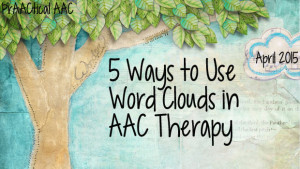
Like many of you, I enjoy using fun websites in AAC therapy sessions. Word clouds are popular therapy tools, both because of their versatility and because they are fun and easy to make. Word clouds are images composed of words on a given topic, where the frequency of use of a word determines its size in the word cloud image. There are lots of websites and apps for this, and most are free. If you are looking for a way to build literacy into your language therapy activities, this may be an option worth exploring. Here are some ideas for prAACtical things to do. Build word knowledge: Use the word cloud to define new words, provide examples, and given synonyms. Once created, you can print these out for a word notebook or display on a vocabulary word wall. You can also keep a digital copy for a vocabulary notebook that... [Read More...]
Filed under: PrAACtical Thinking
Tagged With: implementation ideas, intervention, language therapy, word clouds
April 26, 2015
by Carole Zangari -
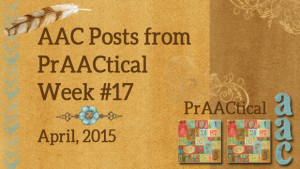
Monday – Let’s Create: Getting to the Core of Earth Day Tuesday – From Solitary Play to Interaction: 5 Things to Try With Kids Who Love Their iPad Games Wednesday – Video of the Week: Progress Monitoring for AT Thursday – More PrAACtical AAC Goals That Matter
Filed under: PrAACtical Thinking









